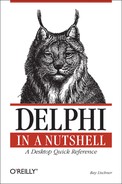Name
Double Type
Description
The Double type is an IEEE standard floating-point
type that uses 8 bytes to store a sign bit, an 11-bit exponent, and a
52-bit mantissa. The mantissa is usually normalized, that is, it has
an implicit 1 bit before the most significant bit. If the exponent is
zero, however, the mantissa is denormalized—without the
implicit 1 bit. Thus, the numerical value of +0.0 is represented by
all zero bits. An exponent of all 1 bits represents infinity
(mantissa is zero) or not-a-number (mantissa is not zero).
The limits of the Double type are approximately
2.23 × 10-308 to 1.79 × 10308,
with about 15 decimal digits of precision. Table 5-1 shows the detailed format of finite and
special Double values.
|
Numeric class |
Sign |
Exponent Bits |
Mantissa Bits |
|
Positive | |||
|
Normalized |
0 |
0...1 to 1...10 |
0...0 to 1...1 |
|
Denormalized |
0 |
0...0 |
0...1 to 1...1 |
|
Zero |
0 |
0...0 |
0...0 |
|
Infinity |
0 |
1...1 |
0...0 |
|
Signaling NaN |
0 |
1...1 |
0...1 to 01...1 |
|
Quiet NaN |
0 |
1...1 |
1...0 to 1...1 |
|
Negative | |||
|
Normalized |
1 |
0...1 to 1...10 |
0...0 to 1...1 |
|
Denormalized |
1 |
0...0 |
0...1 to 1...1 |
|
Zero |
1 |
0...0 |
0...0 |
|
Infinity |
1 |
1...1 |
0...0 |
|
Signaling NaN |
1 |
1...1 |
0...1 to 01...1 |
|
Quiet NaN |
1 |
1...1 |
Tips and Tricks
Doubleis a popular type that provides a good balance between performance and precision.The
Doubletype corresponds to thedoubletype in Java, C, and C++.Refer to the Intel architecture manuals (such as the Pentium Developer’s Manual, volume 3, Architecture and Programming Manual) or IEEE standard 754 for more information about infinity and NaN (not a number). In Delphi, use of a signaling NaN raises runtime error 6 (
EInvalidOp).
Example
type
TDouble = packed record
case Integer of
0: (Float: Double;);
1: (Bytes: array[0..7] of Byte;);
2: (Words: array[0..3] of Word;);
3: (LongWords: array[0..1] of LongWord;);
4: (Int64s: array[0..0] of Int64;);
end;
TFloatClass = (fcPosNorm, fcNegNorm, fcPosDenorm, fcNegDenorm,
fcPosZero, fcNegZero, fcPosInf, fcNegInf, fcQNaN, fcSNan);
// Return the class of a floating-point number: finite, infinity,
// not-a-number; also positive or negative, normalized or denormalized.
// Determine the class by examining the exponent, sign bit,
// and mantissa separately.
function fp_class(X: Double): TFloatClass; overload;
var
XParts: TDouble absolute X;
Negative: Boolean;
Exponent: Word;
Mantissa: Int64;
begin
Negative := (XParts.LongWords[1] and $80000000) <> 0;
Exponent := (XParts.LongWords[1] and $7FF00000) shr 20;
Mantissa := XParts.Int64s[0] and $000FFFFFFFFFFFFF;
// The first three cases can be positive or negative.
// Assume positive, and test the sign bit later.
if (Mantissa = 0) and (Exponent = 0) then
// Mantissa and exponent are both zero, so the number is zero.
Result := fcPosZero
else if Exponent = 0 then
// If the exponent is zero, but the mantissa is not,
// the number is finite but denormalized.
Result := fcPosDenorm
else if Exponent <> $7FF then
// Otherwise, if the exponent is not all 1, the number is normalized.
Result := fcPosNorm
else if Mantissa = 0 then
// Exponent is all 1, and mantissa is all 0 means infinity.
Result := fcPosInf
else
begin
// Exponent is all 1, and mantissa is non-zero, so the value
// is not a number. Test for quiet or signaling NaN.
if (Mantissa and $8000000000000) <> 0 then
Result := fcQNaN
else
Result := fcSNaN;
Exit; // Do not distinguish negative NaNs.
end;
if Negative then
Inc(Result);
end;